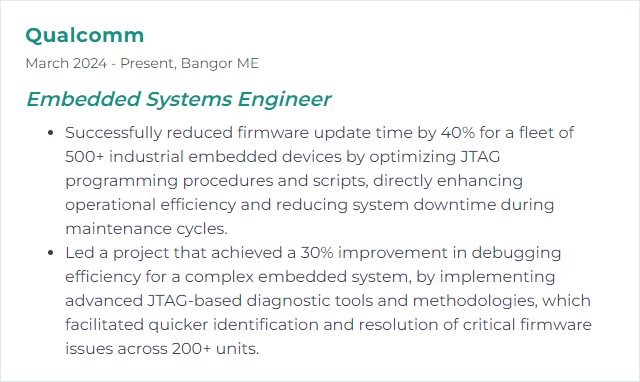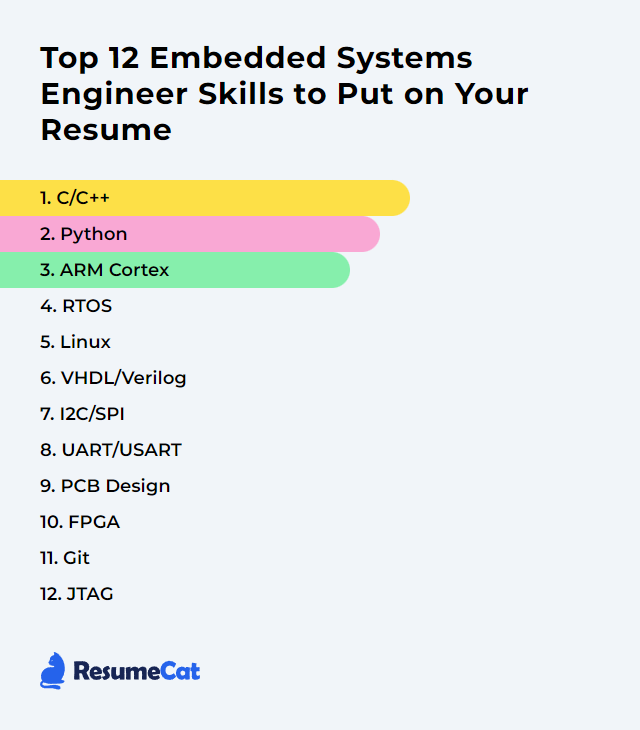Top 12 Embedded Systems Engineer Skills to Put on Your Resume
In the rapidly evolving world of embedded tech, an Embedded Systems Engineer lives at the intersection of hardware and software. Get both hands dirty. Show both sides clearly. On a resume, the particular mix matters: tight code, stable boards, deterministic timing, clean interfaces. Employers skim fast. Sharp skills jump off the page and signal you can build, debug, and deliver.
Embedded Systems Engineer Skills
1. C/C++
C and C++ sit close to the metal. C gives you crisp control over memory, interrupts, and peripherals. C++ layers in abstraction when used carefully: RAII, templates, and strong types that still compile down lean. Both remain the backbone for firmware, drivers, and real-time logic.
Why It's Important
C/C++ grant low-level hardware access, predictable performance, and tight control over memory and timing—core requirements for reliable embedded applications.
How to Improve C/C++ Skills
Own the fundamentals: pointers, volatile, const-correctness, bitfields, endianness, and memory layout. No hand-waving.
Adopt coding standards (MISRA C/C++, CERT). Consistency keeps bugs from breeding.
Work with the hardware: read datasheets, map registers, understand bus timing and cache effects.
Toolchain fluency: cross-compilers, linkers, map files, LTO, and the build system (CMake or equivalent).
Optimize last, but precisely: measure first, tune hot paths, prefer fixed-size types, avoid dynamic allocation in time-critical code.
Debug ruthlessly: GDB, watchpoints, semihosting/SWO logs, and memory corruption hunts with map-file sleuthing.
Static analysis and sanitizers (on host): clang-tidy, cppcheck, UBSan/ASan in simulation or desktop builds.
Unit tests and hardware-in-the-loop: keep logic pure where possible; abstract I/O for testability.
Learn modern embedded C++: careful use of constexpr, templates, and RAII without heap surprises.
How to Display C/C++ Skills on Your Resume

2. Python
Python is the glue and the scalpel: fast scripts, clean tooling, quick experiments. In embedded, it shines for test automation, data collection, log parsing, and host-side utilities. MicroPython and CircuitPython bring it directly onto small targets when needed.
Why It's Important
Rapid iteration, vast libraries, and readable code make Python perfect for orchestration, prototyping, and validating firmware behavior end to end.
How to Improve Python Skills
Build lab tooling: write CLI utilities, test harnesses, and dashboards; interact over serial, USB, TCP.
MicroPython/CircuitPython: practice on boards; respect timing limits and memory ceilings.
Speed where it counts: profile, vectorize with NumPy, or offload hot spots via C extensions when needed.
Concurrency choices: threading for I/O, multiprocessing for CPU-bound, asyncio for many small tasks.
Packaging hygiene: virtual environments, dependency pinning, reproducible builds.
Embedded Linux scripting: automate bring-up, logs, and deployments on target devices.
Test everything: pytest, fixtures for hardware substitutes, golden files for protocol checks.
How to Display Python Skills on Your Resume
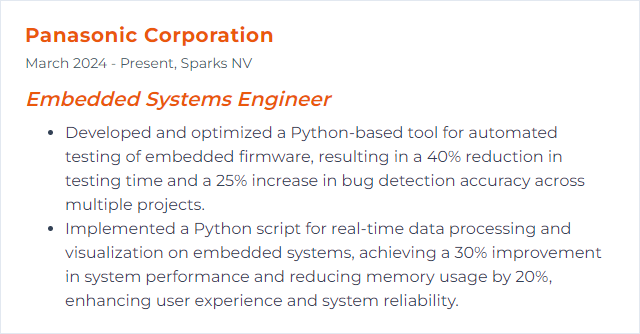
3. ARM Cortex
ARM Cortex refers to families of Arm cores tuned for embedded work: Cortex-M for microcontrollers, Cortex-R for real-time, and Cortex-A for application-class systems. Efficient, scalable, everywhere.
Why It's Important
The Cortex lineup enables tiny low-power nodes and hefty edge processors alike, with well-understood toolchains and a massive ecosystem.
How to Improve ARM Cortex Skills
Know your core: pipeline, exception model, NVIC, memory protection (MPU), caches, and bus fabric.
Use CMSIS and vendor HALs wisely; peel back layers for critical paths.
Lean on DMA to move bytes so the CPU breathes. Configure bursts, alignments, and priorities.
Vector units when available: NEON on A-class, M-Profile Helium (MVE) on newer M-class.
Power states matter: tickless idle, sleep/deep sleep, DVFS where supported.
RTOS pairing: right priorities, bounded stack sizes, lock-free queues where possible.
Memory layout: place ISR code and hot data in fast regions; watch TCM, ITCM/DTCM, and cacheability.
Trace and profile: ITM/SWO, ETM funnels, and cycle counters to chase latency ghosts.
How to Display ARM Cortex Skills on Your Resume

4. RTOS
A Real-Time Operating System coordinates tasks with deadlines. Deterministic scheduling, bounded latency, and predictable resource use—this is where correctness includes time.
Why It's Important
When a missed deadline is a failure, an RTOS keeps systems responsive, structured, and testable.
How to Improve RTOS Skills
Scheduling discipline: priority schemes, avoiding priority inversion, and minimal critical sections.
Latency budgets: measure worst-case ISR and task latency; reduce context switch overhead.
Memory strategy: static allocation, per-task stacks sized by data, and fragmentation avoidance.
Power-aware ticks: tickless idle, event-driven wakeups.
Interrupt design: short ISRs, defer work to tasks, careful nesting, and affinity on SMP targets.
Tracing and observability: timeline views, runtime stats, and watchdogs with bite, not bark.
Security: secure boot, MPU/MPA isolation, guarded IPC.
Updates: robust OTA with A/B or recovery paths; transactional storage.
Right fit RTOS: pick platforms like FreeRTOS or Zephyr based on footprint, drivers, and ecosystem.
How to Display RTOS Skills on Your Resume

5. Linux
Linux is the kernel heart behind many embedded products. With Buildroot or the Yocto Project, you shape userspace, drivers, and services into a tailored system that fits your board like a glove.
Why It's Important
Open, configurable, and battle-tested. The driver ecosystem and tooling make Linux a versatile base for connected devices.
How to Improve Linux Skills
Trim the kernel: enable just what you need; keep modules minimal; understand device trees.
Go real-time when necessary: PREEMPT_RT, IRQ affinity, and CPU isolation.
Filesystem choices: ext4 for general use, F2FS for eMMC, UBIFS for raw NAND; consider read-only roots.
Robust updates: A/B partitions or atomic image swaps; fail-safe bootloaders.
Security posture: hardened configs, least privilege, sandboxing (namespaces, seccomp), and timely patches.
Power management: cpufreq governors, suspend states, device runtime PM.
Networking polish: sysctl tuning, offloads, and lightweight protocols for narrow links.
Cross-compilation at scale: reproducible builds with Yocto or Buildroot; SDKs for teammates.
CI on target: automated tests, smoke checks, and log capture in pipelines.
How to Display Linux Skills on Your Resume
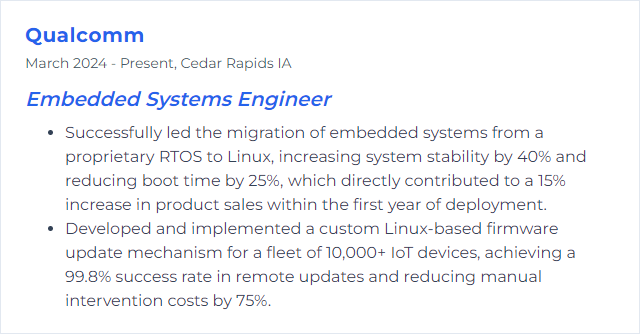
6. VHDL/Verilog
VHDL and Verilog describe hardware, not just behavior. SystemVerilog extends that with verification muscle. You model, simulate, synthesize, and prove timing before gates ever blink.
Why It's Important
Hardware description languages let you craft custom digital logic for performance you can’t squeeze from software alone.
How to Improve VHDL/Verilog Skills
Code for synthesis: clear resets, one clock domain per process, and predictable constructs.
Write strong testbenches: self-checking, constrained random when appropriate, coverage-driven goals.
CDC hygiene: synchronizers, FIFOs, and formal checks on crossings.
Timing closure: accurate constraints, multicycle paths where valid, and realistic I/O models.
Leverage vendor features: DSP blocks, BRAM, SERDES, and PLLs—with intent.
Verification depth: assertions, formal tools, and linting to catch the sneaky stuff.
Read other people’s RTL. Borrow patterns. Avoid anti-patterns.
How to Display VHDL/Verilog Skills on Your Resume

7. I2C/SPI
I2C and SPI are the everyday buses that stitch sensors, memory, and controllers together. I2C is two-wire and addressable, easy to scale. SPI is fast and full-duplex, with chip-select lines per device. Newer designs may also consider I3C as a successor to I2C for higher speeds with backward compatibility.
Why It's Important
These buses define how parts talk. Clean signaling and robust handling make the difference between flaky and rock-solid systems.
How to Improve I2C/SPI Skills
I2C Improvement
Dial in pull-ups based on bus capacitance; rise time matters.
Respect clock stretching; timeouts prevent deadlocks.
Plan addressing early to avoid conflicts; use multiplexers or secondary buses if needed.
Keep traces short, reduce stubs, and consider bus buffers for long runs.
SPI Improvement
Set the right mode (CPOL/CPHA) and don’t forget chip-select setup/hold timing.
Push speed only as far as signal integrity allows; length and impedance bite first.
Use DMA for high-throughput transfers and double-buffer where possible.
General Tips
Good grounding, solid return paths, and clean power decoupling tame noise.
Add CRCs or checksums for critical data; retry strategy for resilience.
Scope and logic analyzer traces tell truths the code won’t.
How to Display I2C/SPI Skills on Your Resume

8. UART/USART
UART moves bytes without a shared clock; USART can also sync with one. Simple, universal, priceless for logs, bootloaders, and low-speed links. Add RS-232 or RS-485 transceivers for distance and noise immunity.
Why It's Important
A dependable serial pipe is the first lifeline for visibility and control, and often the last one standing when other channels fail.
How to Improve UART/USART Skills
Pick baud rates that divide cleanly from your clock to minimize jitter and errors.
Prefer interrupts or DMA over polling; ring buffers prevent overruns.
Use hardware flow control (RTS/CTS) or software flow control (XON/XOFF) when the peer is slower.
Detect and handle framing, parity, and overrun errors; recover cleanly.
For long runs: differential transceivers, proper termination, isolation where safety calls for it.
Shielding and ESD protection keep field failures at bay.
How to Display UART/USART Skills on Your Resume
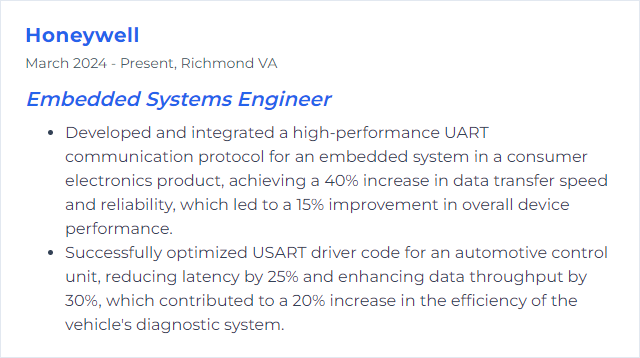
9. PCB Design
PCB design turns schematics into a board that behaves under heat, noise, and time. Placement, routing, and stack-up are engineering, not decoration.
Why It's Important
Great firmware can’t save a bad board. Signal integrity, power stability, and manufacturability start at layout.
How to Improve PCB Design Skills
Plan the stack-up early; define return paths and controlled impedance for high-speed nets.
Power delivery: short, fat routes; decoupling close and varied; low PDN impedance.
Keep loops tight; route differential pairs together; length-match when timing demands.
Thermals: copper pours, vias under hot packages, and airflow paths that actually flow.
EMC from the start: filters, terminations, ground strategy, and enclosure considerations.
DFM/DFT: design with panelization, solder process, and test points in mind.
Creepage/clearance and isolation for high voltage or safety-rated designs.
3D checks: fit, connectors, and cable bend radius with MCAD collaboration.
Review, simulate, prototype, and iterate—paper confidence isn’t field confidence.
How to Display PCB Design Skills on Your Resume
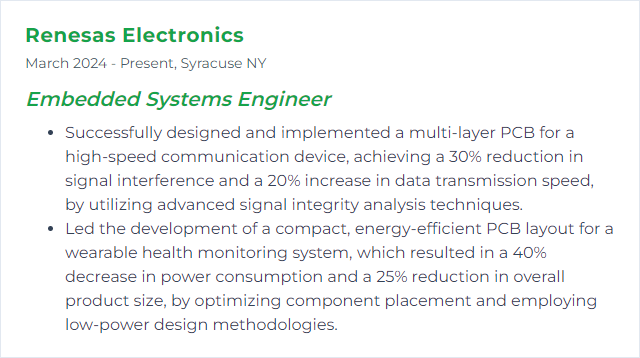
10. FPGA
FPGAs are reconfigurable fabrics for custom logic, accelerators, and time-sensitive pipelines. When microcontrollers tap out, FPGAs keep going.
Why It's Important
They deliver deterministic parallelism and hardware-speed performance without a fixed ASIC cycle.
How to Improve FPGA Skills
Write synthesizable, pipeline-friendly HDL; cut long combinational paths.
Map work to the right resources: DSP slices for math, BRAM for buffers, SERDES for fast I/O.
Clocking: clean domains, jitter-aware PLLs, and bulletproof CDC strategies.
Constraints are contracts: timing, false paths, multicycle paths—all accurate, none guessed.
Floorplan only when necessary; trust tools, then guide them.
Power awareness: clock gating, data gating, and rate changes where logic allows.
Simulate deeply, then use on-chip analyzers (ILA/SignalTap) to see real signals.
Know the tools: Vivado (AMD), Quartus (Intel), Libero (Microchip), and open flows where they fit.
How to Display FPGA Skills on Your Resume
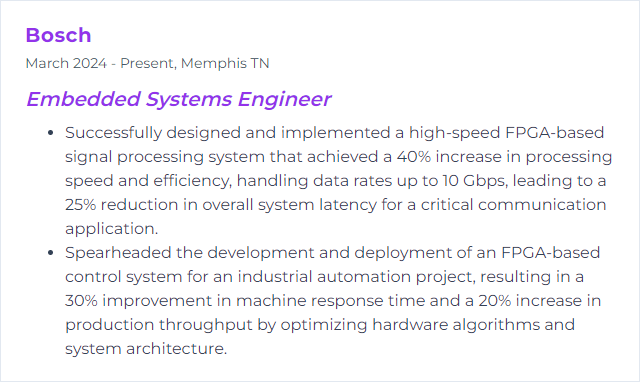
11. Git
Git tracks change and tells the story of your code. In embedded teams, it’s the backbone for collaboration, review, and release traceability.
Why It's Important
Version control protects your work, enables parallel development, and makes shipping repeatable.
How to Improve Git Skills
Branching strategy: feature branches, release branches, and protected main lines.
Commit hygiene: small, atomic, message-rich commits; meaningful history beats noise.
Rebase vs. merge: keep history clean without rewriting published work.
Pull requests and code reviews: enforce checks, templates, and status gates.
Tags and semantic versioning for firm releases and firmware lineage.
Submodules or subtrees when you must; know their trade-offs.
Git LFS for binaries like bitstreams and firmware images.
Hooks automate: formatters, static analysis, and unit tests before code lands.
CI pipelines: build, test, package; GitHub Actions, GitLab CI, or Jenkins—just keep it green.
Bisect problems fast; cherry-pick hotfixes without dragging unwanted baggage.
How to Display Git Skills on Your Resume

12. JTAG
JTAG is the portal into the chip—programming, boundary scan, and deep debug. On Arm targets, SWD often provides a two-wire variant with similar powers.
Why It's Important
Direct access to registers, memory, and trace means faster bring-up, solid test coverage, and recoveries when everything else is silent.
How to Improve JTAG Skills
Know the standards: IEEE 1149.1 boundary scan, 1149.7 compact JTAG, and vendor-specific trace blocks.
Design for test: chain routing, accessible headers, proper pull-ups, and document BSDL files.
Signal integrity: short routes, controlled impedance, series resistors as needed, and clean grounds.
Quality probes matter: reliable adapters and cables cut flaky sessions to zero.
Boundary scan tests catch assembly defects early; script them into production.
Automate flashing, verification, and regression debug flows.
Security-aware: lock/unlock sequences, debug authentication, and lifecycle states.
Use trace intelligently: ITM/SWO for logs, ETM for instruction-level timing when chasing heisenbugs.
How to Display JTAG Skills on Your Resume
